The Five Points of L.A. Mexicano

Ancient rockers have Stonehenge, for Hippies it’s Sedona, but Chicanos look no further than Los Cinco Puntos (5 Points), where an energy vortex of Mexican-American culture fuels the appetite of a city hungry for tacos, tamales, birria, antojitos and mariscos. Here, the grand barrios of Boyle Heights and East L.A. are host to both the best street food trucks and stands anywhere and the best pocho cuisine (food that many second- and third-generation Mexican Americans grew up eating) in America. The neighborhoods surrounding Los Cinco Puntos, a legendary carnicería named after the intersection that’s also home to a pair of Mexican-American war veteran monuments, has drawn Mexican immigrants from nearly every state in Mexico. Five communities have emerged from its tributaries: Sinaloans, Oaxacans, Jaliscans, Nayaritans and Chilangos (as well as the surrounding State of Mexico) to form the reigning cuisines of Mexican food in L.A.
Los Angeles is home to the 2nd largest Oaxacan community in the world, whose moles, tlayudas, chapulines and mezcales are commonplace in the neighborhoods like K-Town, Hollywood, Arlington Heights, West L.A. and Pico-Union. Tapatios (people from Guadalajara) and other Jaliscans have given L.A. and beyond the Mexicanismo of Mariachis, tequila, birria and tortas ahogadas — from the Mariachi Plaza to El Mercadito, their pulsating Son Jaliscience projects the spirit of Mexico here in Mexico’s second largest city, Los Angeles.
In South Central and the Southeast region of L.A., the seafood traditions of the neighboring Pacific Coast states of Nayarit and Sinaloa are found in rowdy restaurants featuring banda, buckets of beer and ceviche, seafood cocktail-centric food trucks and fondas (regional mom and pop restaurants), where regional Sinaloan stews, plates antojitos and breakfasts offer homesick culichis (people from Culiacan) comfort.
At the Mercado Olympic, only the Downtown L.A. skyline reminds you that you’re not at a tianguis (flea market) in one of Mexico City’s working-class neighborhoods. Huaraches, quesadillas, gorditas and tacos filled with tinga, huitlacoche (corn smut), flor de calabaza (squash blossoms) and moronga (blood sausage) are de rigueur, and a handful of sandwich artisans make tortas chilangas as good as you’ll find at Mexico City’s Balderas metro station. Chilangos will put anything in a torta.
Half of the 32 regional cuisines of Mexico are present at any given time in L.A. — in recent years, northern Mexican concepts have trended — still, from these states come the depth and breadth of L.A. Mexicano.
Jalisco

When it comes to Mexican food — Jalisco delivers the goods. Delicious pozoles, menudo and carne en su jugo (meat cooked in its own juices) and simple snacks like sopes, flautas, enchiladas, tacos dorados and heaping tostadas with pickled pig’s feet and tinga fulfill your expectations. Tortas ahogadas (drowned tortas) have improved over the years as legit bread makers have arrived on the scene — Tortas Ahogadas Guadalajara not only excels at the famed sandwich filled with carnitas drowned in a fiery chile de árbol salsa, but their menu is full of popular Tapatio dishes like beef barbacoa tacos, pozole and jericalla (custard). At Tortas Ahogadas Ameca, the sandwiches are delicious and their tacos dorados, enchiladas and pickled pork rind tostadas offer the quintessential Mexican fonda (mom and pop regional restaurant) experience. Legendary taco truck Mariscos Jalisco serves award-winning fried shrimp tacos, ceviche tostadas and seafood cocktails from the town of San Juan de Los Lagos and there are at least a dozen solid houses of birria tatemada (pit roasted goat) like Birrieria Jalisco in Plaza Mexico.
Jaliscan taqueros in South Central and East L.A .are the dominant force behind L.A.’s many tacos de fritanga stands, where offal, chorizo and suadero (A Mexican cut of beef) are fried in a stainless steel disc alongside a steam table of beef tongue, brains and head meat.
Mexico City
There are three destinations for tacos de al pastor in Los Angeles: Leo’s Tacos, Tacos Tamix and Tacos Los Güichos that stand apart from the countless stands and trucks that carve roasted pork marinated in adobo from a vertical spit. At the Mercado Olympic, 40-plus vendors dish Mexico City street food to shoppers in the Produce District hungry for huaraches, tlacoyos, quesadillas and gorditas filled with sautéed mushrooms, tinga, huitlacoche, flor de calabaza, chicharrón prensado and herbed blood sausage.
Mobile hot dog concession stands operating practically 24 hours a day in L.A.’s Mexican enclaves also carry pambazos, a potato and chorizo torta with bread that’s been dipped in a salsa of chile guajillo and blackened on a comal. If you’re willing to make the pilgrimage, D.F. Tamales in Rialto has a menu full of chilango delights, such as lamb barbacoa flautas, the wanton carb-loaded torta de tamal and alambres, a hash of meats, vegetables, bacon and cheese for assembling your own tacos.
Much of the street food in Mexico City comes from bordering states such as Puebla, State of Mexico and a lesser extent, Hidalgo and Tlaxcala—this is also the case in Los Angeles. We have exceptional lamb barbacoa from the State of Mexico at Aqui es Texcoco, tacos of cecina and quelites (wild greens) at Tacos Quetzalcoatl and mouthwatering mixiotes (meat cooked in parchment) at Los Originales Tacos Arabes de Puebla.
Nayarit

On the Beaches of San Blas, Playa Novillero and on the island city of Mexcaltitan de Uribe, fresh fish and shellfish are prepared simply and deftly in Nayarit’s three kitchens of Mexican beach cuisine: barra fria (cold bar), barra caliente (hot bar) and la parrilla (grill). In South Central and the South Bay, koritas (people from Nayarit) use traditional Mexican seafood cocktail technique for tangy ceviches, aguachiles, seafood cocktails and botanas (snacks); cook regional specialties like shrimp a la diabla and cucarachas (deep fried shrimp) and employ grill masters to make Nayarit’s national dish, pescado zarandeado (shaken fish).
In Los Angeles, Jala Mariscos is one of the many food trucks that serve as ambulant raw bars, supplying the Mexican community with one of its favorite indulgences: mariscos(seafood). Rising above the rest, Coni’Seafood imports fish and shrimp from Mexico for their many cooked shrimp dishes like garlic shrimp and drunken shrimp, in their masterful aguachile, and market fresh robalo (snook), for their pescado zarandeado, which is cooked tender throughout the whole fish.
Nayarit-style seafood is all about the best products, fresh lime juice at its optimal tartness and technique. A pilgrimage to Mariscos Chente’s in Lennox to try shrimp ceviche that leans comfortably out of balance towards ground chile jalapeño, skillfully fashioned by the godfather of Mexican seafood in L.A., Vicente Cossio, is a must.
Oaxaca
There a hundreds of Oaxacan restaurants, trucks and stands in Los Angeles serving cuisine mostly from the Valles Centrales and Mixteca region in neighborhoods like K-Town, Arlington Heights, Hollywood, West LA and Pico-Union. Oaxacan cuisine has a rich repertory of pre-Hispanic dishes, for instance, Tejate Doña Roberta in West Adams makes tejate (corn masa and cacao drink) on the weekends and be sure to attend the Feria del Tejate in September and the Feria del Mole in October for empanadas de mole amarillo (yellow mole), a wide variety of Oaxacan moles and piedrazos (hard bread covered in pickled fruits and vegetable).
For a true taste of the Mercado de Tlacolula, Gish Bac has a 3rd generation barbacoa master, Maria Ramos, who makes her family’s goat barbacoa on weekends along with the best tlayudas, atoles (corn masa beverage), enfrijoladas (tortillas covered in black bean puree) and delicious moles like mole coloradito and mole negro.

The mole verde, estofado and mole amarillo at Las 7 Regiones de Oaxaca (Oaxaca has now recognized an 8th region) are a great place to begin your exploration of the seven Oaxacan moles found here in Oaxacalifornia: mole rojo, estofado, coloradito, negro, amarillo, verde and manchamanteles (table-cloth stainer).
The most successful Oaxacan restaurateur in Los Angeles, Zefereno Garcia of Expresion Oaxaqueña, owns six restaurants and markets, including La Mayordomia, where you can grind your ingredients for mole and Oaxacan chocolate as well as shop for a large selection of Oaxacan ingredients. Expresion Oaxaqueña draws a mostly Oaxacan crowd for tasty memelas, enmoladas (tortillas filled with chicken and covered in mole negro), torta sexy (a large Mexican sandwich) and tacos de la abuela, a signature taco introduced by Zeferino.
L.A. also has a Oaxacan celebrity chef in Rocio Camacho from Huajuapan de León, Oaxaca, who does the best mole negro and manchamanteles (table cloth stainer mole), chileajo (chicken in a chile and garlic sauce) and Mexican classics like chiles rellenos served with tomato sauce done with tradition and a chef’s touch at Rocio’s Mexican Kitchen.
Sinaloa
Unlike Nayaritans in L.A., their neighbor to the north has both established a strong seafood presence as well as their land-based traditions in tacos, fondas (regional mom and pop restaurants) and specialists. On Sundays in LA, head to Tacos El Palomas for Mazatlán-style steamed beef head, where five whole heads of steer are cooked for eight hours for making tacos of beef eyes, lips, ears, tongue, brains, head and cheeks.
At Gumacus, you can get chilorio (spicy pork), mochomos (shredded beef), enchiladas del suelo (open ground beef enchilada), asado (beef salad) and other provincial dishes from a genuine fonda. For Seafood and ear piecing banda, restaurants like Mi Lindo Sinaloa and O.C.-based Mariscos Hector offer ceviches, cocktails, and snacks with buckets of beer, curvy waitresses, live music and the contemporary condiments of Sinaloa-style seafood. The flavors of the chucheria (candy shop): tamarind, Tajín (chile salt) and chamoy (sour and spicy condiment) are added to fresh seafood, a trend coming out of Los Mochis and Culiacan, for a uniquely Sinaloan take on Mexican seafood. For fine aguachiles, cylindrical seafood towers and callo de lobina (cured fish) in addition to other Sinaloan seafood classics, El Faro and Los Sitios rule our streets.
Mazatlán-style carne asada has recently become available in Los Angeles and one of the best new taquerias in the city to get it is Tacos La Carreta, which puts real carne asada cooked over mesquite on flour tortillas, finished with pico de gallo, avocado sauce and salsa. The specialty of the house is the vampiro, a carne asada taco on a toasted tortilla, and the chorreada, the same preparation with a sinful spread of asiento, or unrefined lard.
Top Image: Colonia Publica's Fideo | Staci Valentine


